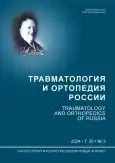Экспериментальное определение коррекционных возможностей пружинной техники при устранении многовершинных деформаций бедренной кости
- Авторы: Соломин Л.Н.1,2, Головёнкин Е.С.1, Сабиров Ф.К.1, Вешнякова А.В.1
-
Учреждения:
- ФГБУ «Национальный медицинский исследовательский центр травматологии и ортопедии им. Р.Р. Вредена» Минздрава России
- ООО «Орто-СУВ»
- Выпуск: Том 30, № 3 (2024)
- Страницы: 75-84
- Раздел: Теоретические и экспериментальные исследования
- URL: https://journal-vniispk.ru/2311-2905/article/view/268330
- DOI: https://doi.org/10.17816/2311-2905-17508
- ID: 268330
Цитировать
Полный текст
Аннотация
Актуальность. Методика коррекции многовершинных деформаций с использованием нескольких ортопедических гексаподов (по одному для каждой вершины деформации) является стандартной. Однако использование двух и более гексаподов на одном сегменте некомфортно для пациента, а расчет в компьютерной программе для каждого из них — это сложный трудоемкий процесс для травматолога-ортопеда. Использование только одного ортопедического гексапода с одним расчетом является достоинством пружинной техники коррекции многовершинных деформаций. Но ее использование затруднено тем, что коррекционные возможности данной методики до настоящего времени неизвестны.
Цель исследования — экспериментально определить коррекционные возможности пружинной техники и сравнить их с возможностями традиционной техники.
Материал и методы. Эксперимент выполнен с использованием пластиковых моделей бедренной кости. В компоновке чрескостного аппарата для фиксации каждого из трех фрагментов были использованы однокольцевые модули. Для имитации мягких тканей использовались поролоновые диски. Выполнялись перемещения мобильной опоры относительно базовой по ширине, под углом, по длине, а также ротационные. Для каждого вида перемещений разрабатывалась специфическая компоновка, которая обеспечивала максимальную величину данного перемещения. Перемещение прекращалось если любая из страт достигала минимальной или максимальной длины, а также в случае, если страта касалась внешних опор, чрескостных элементов или «мягких тканей». Величина каждого вида перемещений при традиционной и пружинной технике сравнивалась с применением U-критерия Манна – Уитни.
Результаты. Коррекционные возможности пружинной техники при использовании всех шести страт, укомплектованных резьбовыми стержнями стандартной длины, на 58–97% (в среднем 72%) ниже, чем при традиционной технике. При замене 2–6 (в зависимости от вида перемещений) резьбовых стержней на более длинные, коррекционные возможности пружинной техники возрастают на 36–466% (в среднем 257%). Это обеспечивает лучшие показатели пружинной техники при перемещениях по ширине (в трех направлениях), а также в перемещениях под углом кнутри (варус) и кпереди (рекурвация).
Заключение. Если страты ортопедического гексапода укомплектованы резьбовыми стержнями бóльшей длины, то коррекционные возможности пружинной техники в 5 из 11 видов перемещений превосходят традиционную технику.
Полный текст
Открыть статью на сайте журналаОб авторах
Леонид Николаевич Соломин
ФГБУ «Национальный медицинский исследовательский центр травматологии и ортопедии им. Р.Р. Вредена» Минздрава России; ООО «Орто-СУВ»
Email: solomin.leonid@gmail.com
ORCID iD: 0000-0003-3705-3280
д-р мед. наук, профессор
Россия, г. Санкт-Петербург; г. Санкт-ПетербургЕвгений Сергеевич Головёнкин
ФГБУ «Национальный медицинский исследовательский центр травматологии и ортопедии им. Р.Р. Вредена» Минздрава России
Автор, ответственный за переписку.
Email: golovenkin_1996@mail.ru
ORCID iD: 0000-0001-7064-5689
Россия, г. Санкт-Петербург
Фаниль Камилжанович Сабиров
ФГБУ «Национальный медицинский исследовательский центр травматологии и ортопедии им. Р.Р. Вредена» Минздрава России
Email: sabirov_fanil@mail.ru
ORCID iD: 0000-0002-0307-0771
канд. мед. наук
Россия, г. Санкт-ПетербургАнна Викторовна Вешнякова
ФГБУ «Национальный медицинский исследовательский центр травматологии и ортопедии им. Р.Р. Вредена» Минздрава России
Email: fantikora@yandex.ru
ORCID iD: 0009-0007-2663-297X
Россия, г. Санкт-Петербург
Список литературы
- Naqui S.Z., Thiryayi W., Foster A., Tselentakis G., Evans M., Day J.B. Correction of simple and complex pediatric deformities using the Taylor-Spatial Frame. J Pediatr Orthop. 2008;28(6):640-647. doi: 10.1097/BPO.0b013e3181831e99.
- Виленский В.А., Захарьян Е.А., Зубаиров Т.Ф., Долгиев Б.Х., Толдиева Х.Б., Фомылина О.А. Лечение двухуровневых деформаций костей голени: два гексапода или один? Современные проблемы науки и образования. 2019;(96):141-141. doi: 10.17513/spno.29352. Vilensky V.A., Zakharyan E.A., Zubairov T.F., Dolgiev B.Kh., Toldieva Kh.B., Fomylina O.A. Treatment of two-level deformities of lower leg bones: two hexapods or one? Modern Problems of Science and Education. Surgery. 2019;(6):141-141. (In Russian). doi: 10.17513/spno.29352.
- Ray V., Popkov D., Lascombes P., Barbier D., Journeau P. Simultaneous multisegmental and multifocal corrections of complex lower limb deformities with a hexapod external fixator. Orthop Traumatol Surg Res. 2023;109(3):103042. doi: 10.1016/j.otsr.2021.103042.
- Massobrio M., Mora R. Hexapod External Fixator Systems: Principles and Current Practice in Orthopaedic Surgery. Springer International Publishing; 2021. p. 61-65; p. 133-152.
- Соломин Л.Н., Щепкина Е.А., Корчагин К.Л., Сабиров Ф.К., Таката М., Цучия Х. Новый способ коррекции многоуровневых деформаций длинных костей с использованием ортопедического гексапода. Травматология и ортопедия России. 2017;23(3):103-109. Solomin L.N., Shchepkina E.A., Korchagin K.L., Sabirov F.K., Takata M., Tsuchia Kh. The New Method of Long Bone Multilevel Deformities Correction Using the Orthopedic Hexapod (Preliminary Report). Traumatology and Orthopedics of Russia. 2017;23(3):103-109. (In Russian).
- Головёнкин Е.С., Соломин Л.Н. Коррекция многовершинных деформаций длинных костей нижних конечностей: обзор литературы. Травматология и ортопедия России. 2023;29(4):134-146. doi: 10.17816/2311-2905-11174. Golovenkin E.S., Solomin L.N. Correction of Multiapical Deformities of Long Bones of the Lower Extremities: A Review. Traumatology and Orthopedics of Russia. 2023;29(4):134-146. (In Russian). doi: 10.17816/2311-2905-11174.
- Соломин Л.Н. Основы чрескостного остеосинтеза. Под ред. Л.Н. Соломина. Москва: БИНОМ; 2014. Т. 1. Solomin L.N. The Basic Principles of External Skeletal Fixation. Solomin L.N. (ed.). Moscow: BINOM; 2014. Vol. 1. (In Russian).
- Попков А.В. Ошибки и осложнения при оперативном удлинении нижних конечностей методом Илизарова у взрослых. Вестник хирургии. 1991;146(1):113-116. Popkov A.V. Errors and complications of operative lengthening of the lower extremities in adults by the Ilizarov method. Bulletin of Surgery. 1991;146(1): 113-116. (In Russian).
- Соломин Л.Н., Скоморошко П.В., Виленский В.А., Утехин, А.И. Оптимизация компоновки аппарата Орто-СУВ для коррекции деформаций дистальной трети диафиза бедренной кости. Травматология и ортопедия России. 2011;17(1):35-41. doi: 10.21823/2311-2905-2011-0-1-35-41. Solomin L.N., Skomoroshko P.V., Vilensky V.A., Utekhin A.I. Optimization of the Ortho-SUV frame assembly for correction of the distal femur deformities. Traumatology and Orthopedics of Russia. 2011;17(1):35-41. (In Russian). doi: 10.21823/2311-2905-2011-0-1-35-41.
- Зырянов С.Я. Одновременное устранение деформа-ций всех сегментов нижней конечности. Гений орто-педии. 1995;(1):53-58. Zyryanov S.Ya. Simultaneous deformity correction of all segments of the lower limb. Genij Ortopedii. 1995;(1):53-58. (In Russian).
- Eralp L., Kocaoglu M., Toker B., Balcı H.I., Awad A. Comparison of fixator-assisted nailing versus circular external fixator for bone realignment of lower extremity angular deformities in rickets disease. Arch Orthop Trauma Surg. 2011;131(5):581-589. doi: 10.1007/s00402-010-1162-8.
- Roy A., Pesenti S., Chalopin A., Peltier E., Jouve J.L., Launay F. Can the TrueLok Hexapod System™ be used to accurately correct lower limb deformity in children? Orthop Traumatol Surg Res. 2020;106(7):1361-1366. doi: 10.1016/j.otsr.2020.06.013.
Дополнительные файлы









